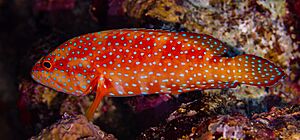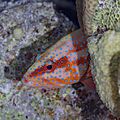Coral grouper facts for kids
Quick facts for kids Coral grouper |
|
|---|---|
 |
|
| Conservation status | |
| Scientific classification | |
| Synonyms | |
|
The coral grouper (Cephalopholis miniata) is a beautiful fish found in the ocean. It's also known as the coral hind or vermillion seabass. This fish is part of the grouper family, which includes other sea creatures like sea basses. You can spot them living near coral reefs in the Indo-Pacific region.
Contents
About the Coral Grouper
The coral grouper has a body that is about 2.6 to 3 times longer than it is deep. Its head is mostly flat or slightly rounded between its eyes. The bone in front of its gill cover (called the preopercle) is rounded and has small, fine teeth. The upper jaw extends past the back of its eye.
What Does It Look Like?
The fins on its back (dorsal fin) have small dips between the spines. It has about 47 to 56 scales along its side, which form a lateral line. The dorsal fin has 9 strong spines and 14 to 15 soft rays. The fin on its underside (anal fin) has 3 spines and 8 to 9 soft rays.
This fish is usually orange-red to reddish-brown in color. It has many small, bright blue spots all over its head, body, and fins. Sometimes, you might see lighter diagonal stripes on its sides. Young coral groupers are orange to yellow. They have fewer, more spread-out faint blue spots. These fish can grow up to 50 centimeters (about 20 inches) long.
Where Do Coral Groupers Live?
Coral groupers live in a large area of the Indo-Pacific. You can find them from the eastern coast of Africa, including the Red Sea, all the way to Durban in South Africa. They also live across the Indian Ocean and into the Pacific Ocean, reaching places like the Line Islands.
They are found as far north as southern Japan and as far south as northern Australia. They live around most islands in the Indian Ocean and the western-central Pacific. However, they haven't been seen in the Persian Gulf or the Gulf of Oman. In Australia, they are found from Western Australia to Queensland, and even at Lord Howe Island.
Life on the Reef
Coral groupers prefer clear waters around coastal and offshore coral reefs. They like areas that are more open rather than very protected. You can often find them hiding in caves or under rocky ledges. They live at depths from 2 meters (about 6.5 feet) down to 150 meters (about 490 feet).
What Do They Eat?
Like other groupers, the coral grouper is a predator. This means it hunts other animals for food. More than 80% of its diet is made up of small fish. They especially like to eat sea goldies. The coral grouper ambushes its prey, rushing out from its hiding spot to catch them. The rest of its diet includes small crustaceans, like crabs or shrimp.
Family Life
Coral groupers live in groups called harems. Each harem has one male and up to 12 females. The male protects his territory, which can be quite large (around 475 square meters or 5,100 square feet). Each female also has a smaller area she defends from other females.
These fish are special because they are protogynous hermaphrodites. This means they start their lives as females and can later change sex to become males. The male swims around his territory, visiting each female. When they meet, they often swim side-by-side.
Discovery of the Coral Grouper
The coral grouper was first officially described in 1775. It was named Perca miniata by a Swedish explorer and naturalist named Peter Forsskål. He found this fish near Jeddah, a city in Saudi Arabia.
Coral Groupers and Humans
The coral grouper is an important fish for local fishing. People catch them using fishing lines, traps, and spears. They are also a popular fish for people who enjoy recreational angling (fishing for fun).
Because they are so colorful, coral groupers are also popular in public aquariums. They are sometimes sold in the aquarium trade, but this is a smaller part of their use.
Gallery
-
A coral grouper in Raja Ampat, Indonesia, in 2014.







